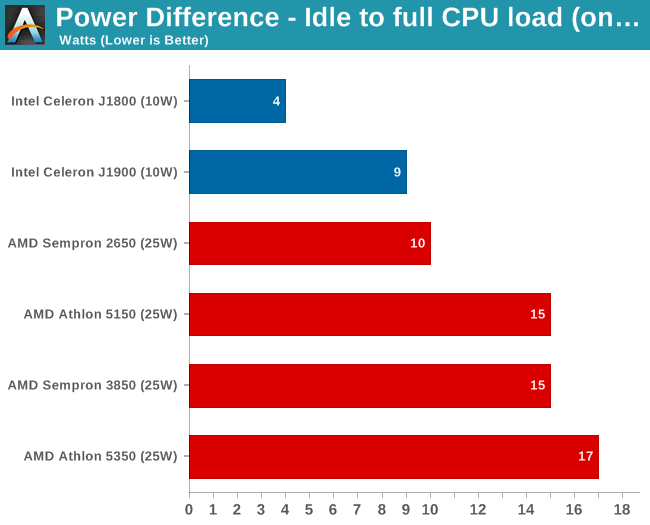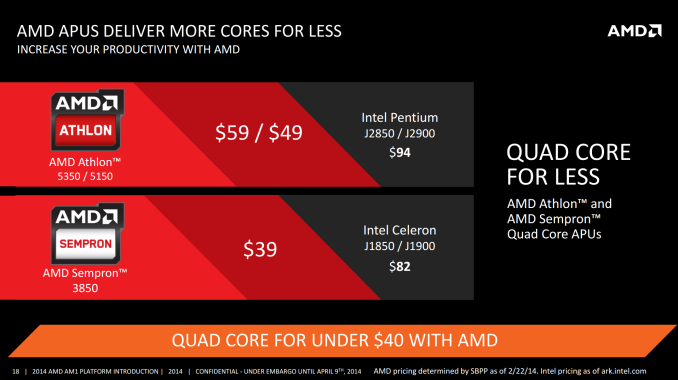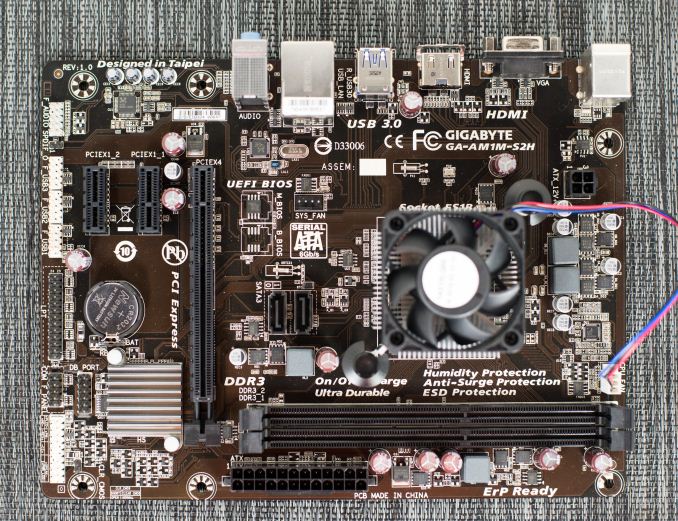AMD AM1 Kabini Part 2: Athlon 5350/5150 and Sempron 3850/2650 Tested
by Ian Cutress on May 29, 2014 2:00 PM ESTThe Competition
Because AMD is the first x86 CPU manufacturer to move their tablet focused processors into the socketed market along with low-cost motherboards, Intel has no direct comparative product. We have to look to their Bay Trail-D SoC range which loses that upgradable functionality. Competition between AMD and Intel on this front is a tit-for-tat operation, with each company focusing on their different strengths. AMD’s integrated IGP aims to be more powerful than the equivalent Intel along with support for DDR3-1600 memory, as well as cheaper overall, however Intel can boast dual channel memory and a lower power output.
With all these differences between Kabini and Bay Trail, including price, power and cores/threads, it is hard to find Intel parts that accurately match each other. AMD has put the following in front of reviewers to provide a guide:
AMD consider the Athlon 5350/5150 parts (quad core, 2.05 GHz and 1.6 GHz) in line with the Intel Pentium J2850/J2900, and the Sempron 3850 with the J1850/J1900. For this Part 2 we were able to obtain full Celeron J1800 (dual core) and Celeron J1900 (quad core) Bay Trail-D parts for testing. Even though AMD puts the Athlon 5350 in the path of the J2900, the J2900 is primarily an OEM solution used by Acer. A single J2900 motherboard appeared on Newegg a week after we had packed up testing.
In fact, I think the 5350 vs the J1900 is a better fit:
| AMD Athlon 5350 vs. Intel Celeron J1900 | ||||
| Athlon 5350 | Celeron J1900 | |||
| CPU Architecture | Jaguar | Silvermont | ||
| CPU Cores | 4 | 4 | ||
| CPU Frequency | 2.05 GHz | 2.0 GHz / 2.4 GHz Turbo | ||
| GPU Cores | 128 SPs | 6 EUs | ||
| GPU Frequency | 600 MHz | 688 MHz | ||
| Memory Channels | Single | Dual | ||
| Memory Frequency | 1600 MHz | 1333 MHz | ||
| L2 Cache | 2 MB | 2 MB | ||
| TDP | 25 W | 10 W | ||
| Price | $59 | $82 | ||
Also we can now directly compare pricing. Take for example the two of the motherboards we had for this review, one J1900 and the other AM1 while equipping the system with an Athlon 5350:
GIGABYTE J1900N-D3V: $87 (Newegg)
GIGABYTE AM1M-S2H: $35 (Newegg)
AMD Athlon 5350: $65 (Newegg)
Totaling up the AMD components gives $100 vs $87 from Newegg, or £65 vs. £66 on Amazon UK, on the extreme high end of a Kabini AM1 setup. Pricing is also influenced slightly by quoting the boxed version of the APU, rather than the OEM pricing that AMD likes to quote.
Our test setup is a follows:
| Test Setup | |
| CPU | AMD Athlon 5350, Quad Core, 2.05 GHz |
| AMD Athlon 5150, Quad Core, 1.60 GHz | |
| AMD Sempron 3850, Quad Core, 1.30 GHz | |
| AMD Sempron 2650, Dual Core, 1.45 GHz | |
| Motherboard | GIGABYTE AM1M-S2H |
| Memory | 2x4GB DDR3-1600 9-10-10 |
| SSD | OCZ Vertex 3 |
| Power Supply | OCZ 1250W ZX Series |
| Graphics | Integrated |
| Graphics Drivers | 14.3 Beta |
Note that for our benchmark results we are also taking data from previous reviews done at AnandTech, including some of the higher powered mainstream systems. Over time we have added benchmarks (such as SYSmark 2014) which are lacking some of the mid-range data.
Power Consumption: Idle to 100% CPU Load (on IGP)

Because of the difference in TDP, the AMD APUs here use more energy, although all four comfortably use less than the 25W TDP. The dual core especially only registered a 10W difference from idle to a full CPU load.













87 Comments
View All Comments
Eeqmcsq - Thursday, May 29, 2014 - link
"... Results are given in minutes, where the Wii itself scores 17.53; meaning that anything above this is faster than an actual Wii..."I think you mean anything "below" this number, since the measurement is in time.
Ian Cutress - Thursday, May 29, 2014 - link
'Above' being above on the graph. I'll just change the wording. I thought I had changed my explanatory template, guess it didn't save...Metalliax - Thursday, May 29, 2014 - link
Why can't review sites please start using sub 150W PSUs for these tests! You should delete your power chart completely unless you can show actual power draw with a PSU that would actually be used in such a setup. I can't believe you think you can post such nonsense with a 1250W PSU.extide - Thursday, May 29, 2014 - link
X2 ! I know you have your reason for using the 1250W PSU (so it's always the same) but the result is USELESS NUMBERS. It doesnt matter if they are comparable if they are utterly useless!easp - Thursday, May 29, 2014 - link
Good call!CU - Thursday, May 29, 2014 - link
Yes, adding haswell celerons like the g1820 and pentiums like the g3220 would be very helpful. Those cpu's plus MB's cost about the same as the Ahtlon 5350.savagemike - Thursday, May 29, 2014 - link
Agree completely. Due to similar costs and the fact I can't passively cool the AMD stuff anyway these are the Intels I'd be comparing them to for a budget build.azazel1024 - Thursday, May 29, 2014 - link
I guess you can consider the IGP benchmarks for something, because I assume it would mean some older and more casual games would be likely to run fine, where as with the Bay Trail IGP they might not. However, at least based on the benchmarks used, even the AMD's IGP here in these low end processors is not up to the task of playable frame rates. Unless I am missing something, this was 1280x1024 at LOWEST settings and they were hitting mid 20's on average frame rates. That may be playable to some and bumping it down to 1280x720 might get you in to the low 30's...but that is still barely, barely playable at best.Which makes me wonder...what would a Pentium or Celeron Haswell that might cost less manage in terms of performance. The IGP is a fair amount more capable, especially the ones with HD4400 on there...which is MASSIVELY more performance than either the Bay Trail or Kabini has...at the same price. Granted, higher TDP, but based on what I know of the actual power consumption of the processors, Haswell Celeron/Pentium might only be a litteral handful of watts more (5-10) under load and probably around the same idle.
Low end board + low end Haswell processor runs ~$100 combined...same price as the high end Kabini and WAYYYYYY more performance.
ozzuneoj86 - Thursday, May 29, 2014 - link
I don't really understand the inclusion of so many recent high end chips. For future reviews of this nature you could probably cut out all but one mid\high end CPU from each vendor, and you'd save a huge amount of benchmarking time.Along with that, it doesn't seem like I've really learned much from many of the benchmarks, since all we have to compare are high end, high TDP CPUs from the past 3 years, and these AM1 Kabini chips... as expected, the Kabinis are all similar in performance (with slight increases from least to most expensive), and the high end CPUs are significantly faster. Readers probably already knew that without the benchmarks though.
It'd be far more useful to compare these to older CPUs and their low wattage variants, such as Core 2 Duos and Quads, AM2\AM3 Athlon X2 and X4 CPUs, as well as other low power chips that are common these days, like the Ivy Bridge based Celeron 1037u, Sandy Bridge Celeron 847, AMD E-350... even an old Atom (from the Ion platform era) would be helpful for those upgrading aging HTPCs. Not to mention any of the direct competition for these chips, like the Ivy\Haswell Celerons and Pentiums.
It'd also be nice to have something to compare the dedicated GPU results to... like the Celeron J1900, or any of the CPUs mentioned above. There are many J1800\J1900 boards out there that can have a dedicated GPU installed.
Also, as others have mentioned, the power consumption numbers with such a high wattage PSU aren't very helpful either.
If its a matter of not having the hardware on hand, we're talking about low end hardware... you could probably get a decent example of almost everything I mentioned for a few hundred dollars total. Besides, I'm sure readers would gladly donate some hardware if it meant having it used in benchmarks for a few years.
Thanks for the article, I just feel like it could have been much more focused on the products being reviewed and how they compare to the competition.
ozzuneoj86 - Thursday, May 29, 2014 - link
Just remembered something else...The game benchmarks need to include older games. One or two examples of recent games that are nearly unplayable would be enough to let us know what we can't do with these... but a few old games, or even highly popular current games that don't require much power would be far more likely to influence someone's buying decisions.
Will it run Minecraft at 1080P? How about 720P? How about a few games from 4-5 years ago?